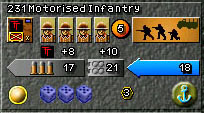
Example of a unit in Amphibious Mode
note the 'blue dice' to reflect the chances
of losses being taken upon landing.
All amphibious operations are conducted through sea lanes. These are specified by the scenario creator and act to channel all movement at sea and on beaches by amphibious and naval units.
For instance, on the first landing turn in Battles in Normandy, a sea lane leads from the edge of the map through the sea to the three hexes of Utah beach. The US 90th and 4th Infantry Divisions, along with sundry other units start in this sea lane, and can only move along it to the beach hexes. They don’t have to land, but they won’t achieve much if they don’t!
When an amphibious unit reaches a beach hex, a button with an anchor symbol appears on the unit. Hitting the anchor button will land the unit, but that’s not necessarily the best thing to do. Unfortunately for amphibious units, any enemy combat, support or forts and strongpoint units within a certain range of the landing unit have a chance to cause casualties on the turn that it lands.
The range at which defenders can cause attrition, and their chance to do so are chosen by the scenario designer, and can vary from turn to turn. On the first landing turn of Battles in Normandy, the range is three hexes, and every step of every combat, support and fort and strongpoint units makes an equal contribution to the chances of attrition, regardless of what type of step it is. So if three one step strongpoints and one three step fort are within attrition range of the same beachhead hex, then killing all the strongpoints will have the same effect on lowering attrition chances as killing all three steps of the fort.
The odds of this attrition occurring are calculated, and are displayed on the unit itself as it reaches shore but before the landing command is given. These are displayed as small dice. The number of dice equals the number of rolls and the number on the dice is the minimum number required to cause a step loss. So, for example, a unit showing three dice with a 5 on the dice has 3 rolls where a 5 or a 6 will cause a step loss. The range within which enemy unit can cause casualties is also shown.

Example of a unit in Amphibious Mode
note the 'blue dice' to reflect the chances
of losses being taken upon landing.
When the command to land is given, the computer rolls the dice and any casualties are instantly applied. A unit that has landed is now a land unit. It may or may not be able to move, and may or may not have its Combat Capability, depending on the choice of the scenario designer.
A unit can never roll more dice than it has steps, so a 4 step unit would have to be unlucky to be completely eliminated. However, 2 and especially 1 step units are quite vulnerable to bad luck. This means that players should be reluctant to commit small units, especially artillery and supply units to the first wave, unless the naval bombardment has been exceptionally successful, and there are no German defenders within range of the beach.
Since the amphibious units have plenty of movement range, it easy to check out the odds at each beach hex before making a decision. A challenging but fun part of Battles in Normandy will be planning your bombardments and your landing to minimise casualties.
On the first few turns, sea lanes lead units directly to their nominated landing beach. However, after a few days other lanes become active, and American units can be directed by the player to any US beach, and British units to any British beach.
Sea lanes also constrain the movement of naval units. Destroyers, Cruisers and Battleships all have their own lanes. Obviously, Destroyers can get closer to the beach than Cruisers or Battleships. Ships can attack Strongpoints and Forts, clearing the beaches for the landing craft.
Each ship gets one shot per turn at any fortification step. The type of fort or strongpoint is irrelevant to its dice roll to destroy a step. Dice rolls are as follows: Battleships 2-6, Gunship 3-6, Heavy Cruisers 3-6, Light Cruisers 4-6, Destroyers 5-6 and Destroyer Escorts 6.

An example of a ship unit. In this case
the USS Nevada a Battleship.
Destroyers, but not Cruisers or Battleships can act like artillery units, supporting units in combat. Each Destroyer can supply a +1 combat shift. Certain ships, usually Battleships, can also bombard hexes, causing interdiction.
Bombardment, Combat Support and Interdiction all use a ship’s Combat Capability, so a ship can only do one of these per turn.
Though not used in Battles in Normandy, the system will allow troops already on land to turn themselves into amphibious units, move through sealanes and land elsewhere..